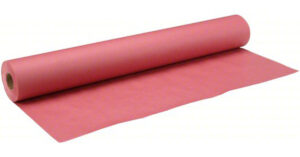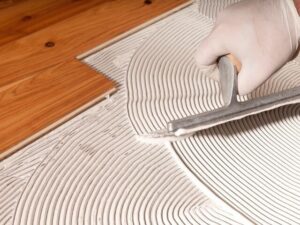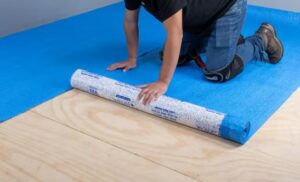Do I need an underlayment when installing hardwood floors?
Posted: August 19, 2024Author – Ryan Palma Owner/CEO Sustainable Lumber Co
For more information and pricing on our sustainable hardwood flooring, please contact us.

Understanding the Basics
Vapor Barrier: A material that prevents moisture from passing through. This is especially important in areas where moisture can seep up from the subfloor, like basements or ground-level installations.
Underlayment: A layer of material placed between the subfloor and the hardwood. It can serve multiple purposes, such as providing cushioning, soundproofing, and additional moisture protection.
Types of Subfloors and their Requirements
1. Concrete Subfloor
If you’re installing hardwood floors on a concrete subfloor, a vapor barrier is crucial. Concrete is porous and can allow moisture to seep up, which can damage hardwood flooring over time. Here is what you can use:
Plastic Sheet: There are many choices and brands available, it is important to contact a local professional before making a final decision.

2. Plywood or OSB Subfloor
For installations over wood subfloors, the primary concern is less about moisture and more about providing a smooth surface and reducing noise. Options include
Rosin Paper: Helps reduce squeaks and offers a slight barrier against moisture.
Felt: Provides similar benefits to rosin paper with additional cushioning.
Underlayment: There are many other options available at box stores and flooring stores, consult local professionals in your area for recommendations.
Installation Methods and Underlayment
The method you choose to install your hardwood floor can also influence your need for underlayment:
1. Floating Floor Installation

2. Nail Down or Staple Down Installation
For these traditional installation methods, the need for an underlayment can vary. A moisture barrier, while not always necessary, can provide extra protection. If you choose to use rosin paper, this can help prevent squeaks and offer minor resistance to moisture.
Manufacturer’s Guidelines
Always refer to the manufacturer’s guidelines for the specific type of hardwood flooring you are installing. These guidelines will provide the best recommendations for underlayment and vapor barriers tailored to your flooring type and installation method.
Conclusion
Choosing the right underlayment or vapor barrier is essential for ensuring the longevity and performance of your hardwood floors. By understanding your subfloor type and installation method, you can make an informed decision that will keep your floors looking beautiful for years to come.
Questions
Our knowledgeable and educated staff is here to answer any additional questions you may have. Please call us today for a free quote: Ph# 406.642.7120 or click here to submit an inquiry online. We look forward to working with you on your next project!
